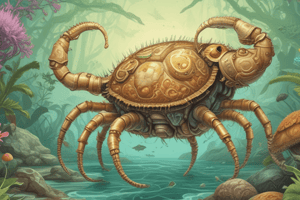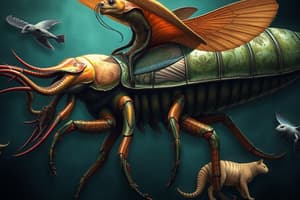Podcast
Questions and Answers
What is the characteristic of phylum Porifera regarding their body structure?
What is the characteristic of phylum Porifera regarding their body structure?
- Bilateral symmetry
- Simple, multicellular structure (correct)
- True body cavity
- Segmented body
Which of the following phyla is characterized by bilateral symmetry and a flat, ribbon-like body?
Which of the following phyla is characterized by bilateral symmetry and a flat, ribbon-like body?
- Phylum Annelida
- Phylum Platyhelminthes (correct)
- Phylum Chordata
- Phylum Arthropoda
What is the characteristic of phylum Annelida regarding their body cavity?
What is the characteristic of phylum Annelida regarding their body cavity?
- Simple nervous system
- Filter feeders
- True body cavity (coelom) (correct)
- No internal body cavity
Which of the following phyla is characterized by jointed appendages and an exoskeleton?
Which of the following phyla is characterized by jointed appendages and an exoskeleton?
What is the characteristic of phylum Chordata regarding their embryonic stage?
What is the characteristic of phylum Chordata regarding their embryonic stage?
Which of the following is an example of phylum Porifera?
Which of the following is an example of phylum Porifera?
Which phylum is characterized by filter feeders?
Which phylum is characterized by filter feeders?
Which of the following is a common habitat for phylum Platyhelminthes?
Which of the following is a common habitat for phylum Platyhelminthes?
Study Notes
Phylum Porifera
- Porifera means "pore-bearing" in Latin
- Characterized by:
- Perforated body walls
- Simple, multicellular structure
- No true tissues or organs
- Filter feeders
- Examples:
- Sponges
- Sea sponges
- Habitat:
- Marine environments
- Freshwater environments
Phylum Platyhelminthes
- Flatworms
- Characterized by:
- Bilateral symmetry
- Flat, ribbon-like body
- No internal body cavity
- Simple nervous system
- Examples:
- Tapeworms
- Liver flukes
- Free-living flatworms
- Habitat:
- Freshwater environments
- Marine environments
- Terrestrial environments
Phylum Annelida
- Segmented worms
- Characterized by:
- Bilateral symmetry
- Segmented body
- True body cavity (coelom)
- Closed circulatory system
- Examples:
- Earthworms
- Leeches
- Marine worms
- Habitat:
- Freshwater environments
- Marine environments
- Terrestrial environments
Phylum Arthropoda
- Jointed-legged animals
- Characterized by:
- Bilateral symmetry
- Jointed appendages (legs, antennae)
- Exoskeleton (made of chitin)
- Segmented body
- Examples:
- Insects (beetles, flies, bees)
- Crustaceans (crabs, lobsters, shrimp)
- Arachnids (spiders, scorpions)
- Centipedes
- Habitat:
- Terrestrial environments
- Freshwater environments
- Marine environments
Phylum Chordata
- Animals with a notochord (a flexible, rod-like structure)
- Characterized by:
- Bilateral symmetry
- Notochord (present in embryonic stage)
- Dorsal hollow nerve cord
- Pharyngeal slits
- Examples:
- Vertebrates (fish, amphibians, reptiles, birds, mammals)
- Invertebrates (tunicates, lancelets)
- Habitat:
- Freshwater environments
- Marine environments
- Terrestrial environments
Phylum Porifera
- Characterized by perforated body walls, simple multicellular structure, and no true tissues or organs
- Filter feeders, with pores allowing water to flow through their bodies
- Found in marine and freshwater environments
- Examples include sponges and sea sponges
Phylum Platyhelminthes
- Characterized by bilateral symmetry and a flat, ribbon-like body
- Lack an internal body cavity and have a simple nervous system
- Found in freshwater, marine, and terrestrial environments
- Examples include tapeworms, liver flukes, and free-living flatworms
Phylum Annelida
- Characterized by bilateral symmetry and a segmented body with a true body cavity (coelom)
- Have a closed circulatory system and a simple nervous system
- Found in freshwater, marine, and terrestrial environments
- Examples include earthworms, leeches, and marine worms
Phylum Arthropoda
- Characterized by bilateral symmetry, jointed appendages, and an exoskeleton made of chitin
- Have a segmented body and a complex nervous system
- Found in terrestrial, freshwater, and marine environments
- Examples include insects, crustaceans, arachnids, and centipedes
Phylum Chordata
- Characterized by bilateral symmetry, a notochord (present in embryonic stage), and a dorsal hollow nerve cord
- Pharyngeal slits are present in embryonic stage
- Found in freshwater, marine, and terrestrial environments
- Examples include vertebrates (fish, amphibians, reptiles, birds, mammals) and invertebrates (tunicates, lancelets)
Studying That Suits You
Use AI to generate personalized quizzes and flashcards to suit your learning preferences.
Description
Learn about the characteristics, examples, and habitats of Phylum Porifera and Phylum Platyhelminthes, including sponges, flatworms, and tapeworms.




